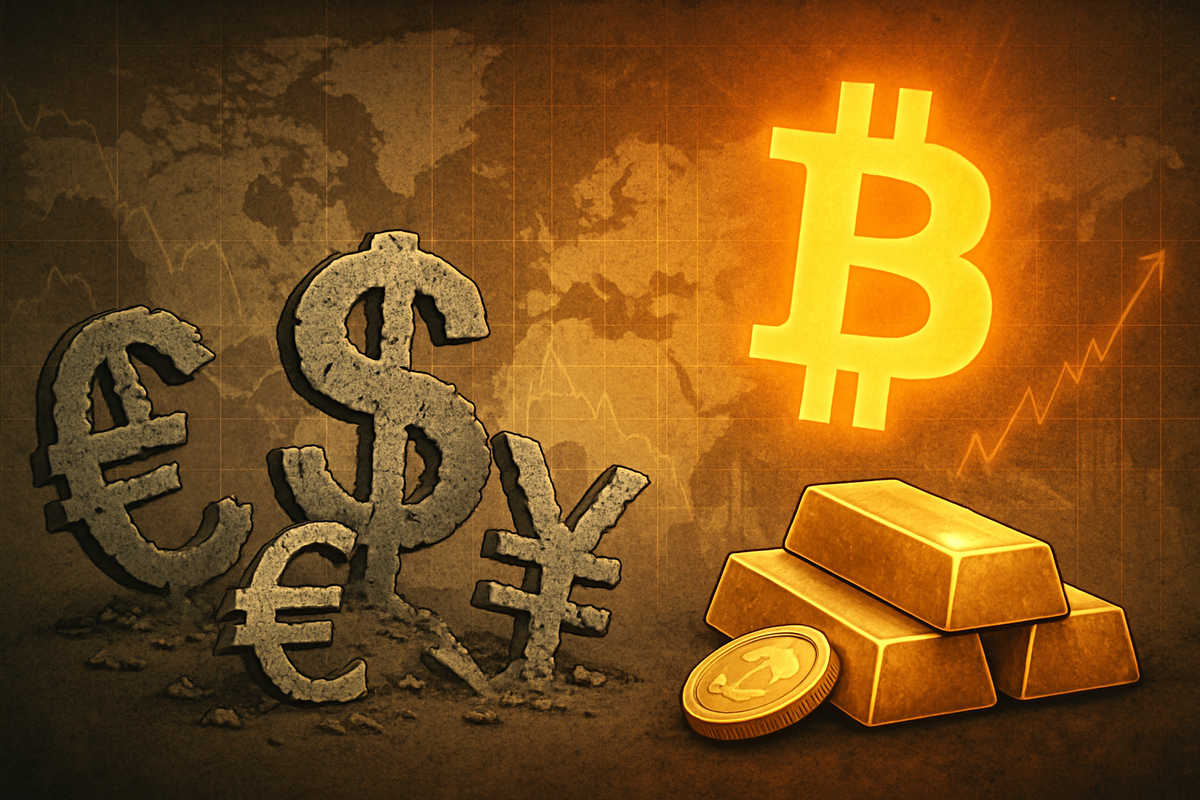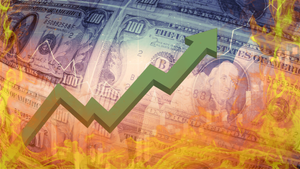
A profound shift is underway in the global financial markets, as growing distrust in the US dollar and other major reserve currencies propels gold and Bitcoin to unprecedented record rallies. This seismic re-evaluation of traditional monetary systems is leading investors to seek refuge in alternative stores of value, with immediate and far-reaching implications for portfolios and the broader financial landscape. The phenomenon, dubbed by some as a "debasement trade," highlights deep-seated concerns over inflation, sovereign debt, and geopolitical instability, fundamentally altering investment strategies and questioning the long-held dominance of fiat currencies.
The current environment sees gold, the perennial safe-haven asset, breaching the significant psychological barrier of $4,000 per ounce for the first time in history. This milestone follows an extraordinary run, with spot gold prices having surged by approximately 50% so far in 2025, building on impressive gains of 27% in 2024 and 13% in 2023. As of October 7, 2025, gold (XAU) closed at $3,863.53, marking a 45.2% increase over the past year, with current prices hovering around $3,994.41. Simultaneously, Bitcoin, often hailed as "digital gold," has also shattered records, soaring past $125,000 to reach $125,700 on October 5, 2025. This digital asset has gained over 30% this year, with a staggering 103.78% increase over the last 12 months, adding over $61,464.14 to its value.
The Unraveling of Trust: A Timeline of Discontent
The roots of this profound distrust in major reserve currencies, particularly the US dollar, can be traced through a series of escalating economic and geopolitical events. Persistent inflation, the dollar's depreciation against the DXY index (losing approximately 10% this year), and an ever-expanding US national debt have fueled concerns over US sovereign risk and fiscal instability. Citadel CEO Ken Griffin has openly warned of a "debasement trade," where investors are actively abandoning the dollar. Political polarization within the US, punitive tariff policies, and the "weaponization" of the dollar through sanctions have further eroded international confidence, leading some nations to view dollar reliance as a strategic vulnerability.
This sentiment extends beyond the US dollar. The Euro has faced instability due to political conflicts in France, including multiple prime ministerial resignations and difficulties in agreeing on budget deficit reductions. The Japanese Yen has also experienced a sharp drop, influenced by pro-stimulus policies and concerns regarding the independence of its central bank. This widespread vulnerability across major fiat currencies has created a fertile ground for alternative assets.
The timeline of these rallies reveals a clear response to these pressures. Gold's consistent upward trajectory since 2023, accelerating significantly in 2025, coincides with heightened geopolitical tensions and central banks' aggressive gold accumulation strategies. Central banks, particularly in emerging markets and BRICS nations, now hold almost 20% of global official reserves in gold, actively diversifying away from the dollar. For Bitcoin, the narrative of "digital gold" gained significant traction following past banking crises and continued dollar weakness. The crucial approval of spot Bitcoin ETFs by the US financial regulator in January 2024 marked a turning point, ushering in "institutional maturity" and providing regulated avenues for significant capital inflows. These ETFs have seen substantial interest, cementing Bitcoin's role in the portfolios of both retail and institutional investors.
Initial market reactions reflect a frantic reallocation of capital. Investors are moving away from traditional currency-denominated assets, with some advocating for up to a 20% allocation to alternatives like precious metals and cryptocurrencies, a stark departure from the conventional 60% stocks/40% bonds structure. This shift indicates a profound re-evaluation of risk and value in a rapidly evolving global financial order.
Corporate Fortunes: Winners and Losers in the New Monetary Order
The ongoing flight from traditional reserve currencies into gold and Bitcoin is creating distinct winners and losers across various industries, particularly impacting public companies.
Companies directly involved in gold mining and exploration are clear beneficiaries. Major gold producers like Barrick Gold Corp. (NYSE: GOLD) and Newmont Corporation (NYSE: NEM) are experiencing significant boosts to their revenue and profitability as gold prices soar. Higher gold prices mean increased margins on extracted gold, leading to enhanced cash flows and potentially higher dividends for shareholders. Exploration companies, often smaller and more speculative, may find it easier to raise capital for new projects, given the increased investor interest in the sector. Equipment suppliers to the mining industry also stand to gain from increased activity and investment in gold production.
In the cryptocurrency space, cryptocurrency exchanges and blockchain technology providers are seeing substantial increases in trading volumes and user adoption. Companies like Coinbase Global, Inc. (NASDAQ: COIN), a leading cryptocurrency exchange, benefit directly from increased Bitcoin trading activity through transaction fees. Firms providing infrastructure for the crypto ecosystem, such as those involved in secure storage, payment processing, or even specialized hardware for mining (though less directly tied to Bitcoin's price rally itself, but more to overall crypto interest), are also poised for growth. The institutional adoption driven by Bitcoin ETFs has further bolstered the legitimacy and operational scale of these companies.
Conversely, traditional financial institutions heavily reliant on the stability and dominance of the US dollar could face headwinds. Banks with significant holdings in US Treasury bonds or those whose business models are deeply intertwined with dollar-denominated international trade might see a depreciation in asset values or a reduction in their competitive advantage if de-dollarization accelerates. While large diversified banks like JPMorgan Chase & Co. (NYSE: JPM) or Bank of America Corporation (NYSE: BAC) have broad exposures, a sustained erosion of dollar confidence could impact their international operations and foreign exchange revenues.
Furthermore, companies that generate a significant portion of their revenue from exporting goods priced in US dollars could face challenges if the dollar continues to weaken against other major currencies, making their products more expensive for international buyers. Similarly, countries or corporations with large dollar-denominated debt might find the real cost of servicing that debt increasing if their local currencies strengthen against a depreciating dollar, although this is a more complex interplay of factors. The overall sentiment shift could also lead to a broader underperformance of US financial assets, impacting US equity and fixed income markets and the companies within them.
A Systemic Shift: Wider Significance and Historical Parallels
This surge in gold and Bitcoin, driven by a weakening trust in reserve currencies, is not merely a transient market phenomenon but a symptom of a deeper, systemic shift in the global financial order. It signifies a growing disillusionment with the efficacy of traditional monetary policy, particularly the perceived debasement of fiat currencies through expansive quantitative easing and unchecked national debt accumulation. This event fits squarely into broader industry trends emphasizing diversification away from concentrated currency risk and the search for inflation hedges in an era of persistent price pressures.
The potential ripple effects are profound. For competitors and partners, this trend could accelerate the push towards a multipolar currency system, diminishing the US dollar's long-standing role as the world's primary reserve currency and medium of exchange. This could empower economic blocs like BRICS, which are already exploring alternative trade settlement mechanisms and actively accumulating gold reserves to reduce dollar dependence. Such a shift would alter global trade dynamics, foreign exchange markets, and international capital flows.
Regulatory and policy implications are also significant. Governments and central banks may face increased pressure to address fiscal imbalances and restore confidence in their national currencies. The rise of Bitcoin and other cryptocurrencies as legitimate investment assets will likely necessitate further regulatory frameworks to manage their integration into the mainstream financial system, ensure investor protection, and mitigate risks associated with their volatility and decentralized nature. The approval of spot Bitcoin ETFs is just the beginning; expect more discussions around digital asset regulation globally.
Historically, periods of currency instability and geopolitical uncertainty have often seen a flight to gold. The 1970s, characterized by the end of the Bretton Woods system and high inflation, saw gold prices skyrocket. More recently, post-2008 financial crisis, gold also experienced significant rallies as investors sought safety. The current situation, however, is unique in its dual-asset response, with Bitcoin emerging as a viable "digital gold" alternative. This comparison highlights a modern evolution of the safe-haven concept, adapting to the digital age while retaining the core principle of seeking assets outside direct governmental control. The current distrust isn't just about inflation; it's also about sovereign risk and the perceived weaponization of currency, adding another layer of complexity to the historical precedents.
Navigating the New Frontier: What Comes Next
The current trajectory suggests that the forces propelling gold and Bitcoin rallies are likely to persist, shaping both short-term and long-term possibilities for investors and the global financial system.
In the short-term, continued volatility in traditional markets and ongoing geopolitical tensions are expected to sustain demand for both assets. Gold prices are projected to potentially exceed $4,000 per ounce by year-end 2025, with some analysts forecasting further gains into 2026, possibly reaching $4,200-$4,500. Bitcoin, too, is anticipated to see further appreciation, with near-term targets around $135,000 and some bullish predictions reaching $200,000 by the end of 2025, or between $80,000 and $125,000 by the end of 2024. Investors should anticipate continued inflows into gold-backed ETFs and cryptocurrency investment vehicles, driving price momentum. However, both assets remain susceptible to profit-taking and macroeconomic shifts, particularly any unexpected strengthening of the US dollar or a significant de-escalation of global tensions.
Long-term, the implications are more profound. The trend of de-dollarization and the search for alternative reserve assets could accelerate, leading to a more diversified and potentially fragmented global financial system. Central banks and sovereign wealth funds may continue to rebalance their portfolios away from traditional fiat currencies. This could necessitate strategic pivots for international businesses and financial institutions, requiring them to adapt to a multi-currency environment and potentially increased currency volatility.
Market opportunities will emerge in sectors that facilitate this shift. Beyond gold mining and crypto exchanges, companies offering secure digital asset custody solutions, blockchain-based financial services, and innovative commodity trading platforms could see significant growth. Challenges include managing the inherent volatility of cryptocurrencies and navigating evolving regulatory landscapes. Potential scenarios range from a gradual, managed transition to a multipolar currency world to more disruptive shifts if confidence in major reserve currencies erodes more rapidly. Investors should closely monitor central bank policies, geopolitical developments, and the regulatory treatment of digital assets.
The Enduring Allure of Scarcity: A Comprehensive Wrap-up
The record rallies in gold and Bitcoin are a powerful testament to a fundamental shift in investor sentiment: a growing distrust in the stability and long-term purchasing power of the US dollar and other major reserve currencies. Key takeaways include the unprecedented price levels achieved by both assets, driven by persistent inflation, mounting sovereign debt, geopolitical uncertainties, and strategic diversification efforts by central banks and institutional investors. The "debasement trade" is not just a niche strategy but a widespread re-evaluation of portfolio construction.
Moving forward, the market is likely to continue favoring assets perceived as scarce, decentralized, or historically reliable stores of value. Gold's enduring appeal as a safe haven, coupled with Bitcoin's emergence as "digital gold" and its increasing institutional acceptance, positions both assets as critical components in modern investment portfolios. The long-term significance of this trend lies in its potential to reshape the global monetary order, fostering a more diversified and perhaps less dollar-centric financial system.
Investors should watch for several key indicators in the coming months: the trajectory of inflation rates globally, central bank interest rate decisions (particularly from the US Federal Reserve), further geopolitical developments, and any new regulatory announcements concerning cryptocurrencies. The continued accumulation of gold by central banks and the sustained growth of institutional inflows into Bitcoin ETFs will also serve as vital signals. While offering significant opportunities, investors must also remain cognizant of the inherent risks, particularly the volatility associated with Bitcoin, and ensure their portfolios are diversified and aligned with their risk tolerance. This content is intended for informational purposes only and is not financial advice





